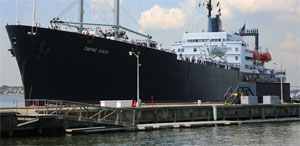A group of 26 members of Congress is seeking money to design and build new training vessels for the six state maritime academies.
If built, these vessels would train future merchant mariners and also be used for disaster relief and humanitarian missions, according to Kimberly Strong, spokeswoman for the Maritime Administration (MarAd).
The congressional members sent a letter on Nov. 21 to President Obama, the head of the Office of Management and Budget and the secretary of the Department of Transportation (DOT) asking for money for the design of a new training vessel and multi-year replacement funding in the fiscal year 2016 budget.
In February, the president’s budget proposal included $5 million for the design phase.
The state academies’ training ships typically have been retired vessels that were taken out of their previous service. The average age of the current six training ships is 35 years. The oldest ship, State University of New York Maritime College’s Empire State VI, is 53 years old.
“It doesn’t make sense for the federal government to take old ships and invest money to repurpose them,” said Rear Adm. Richard G. Gurnon, president of Massachusetts Maritime Academy. “It would make sense to build them from the keel up.”
MarAd, which would own the new vessels, did not provide any details about them. “We fully recognize the need to recapitalize these vessels and are examining various options, including the development of a new purpose-built class of ships,” Strong said.
MarAd has been meeting with the state maritime academies to determine the best design to train mariners. In addition, MarAd is consulting with federal agencies to find out what additional capabilities this class of ship would need to respond to national and international crises. MarAd is making the recapitalization effort “one of our top priorities,” said Strong.
Massachusetts Maritime’s training vessel, Kennedy, is 47 years old. Texas A&M Maritime Academy’s General Rudder is 31 years old. The training vessels for the California Maritime Academy and the Great Lakes Maritime Academy are each 28 years old. Maine Maritime Academy’s State of Maine is 24 years old.
Because of limitations due to the piers and harbors at the maritime academies, the new ships cannot be longer than 600 feet, have a beam more than about 85 feet and a draft deeper than 28 feet, Gurnon said. They would need to house between 700 and 800 cadets for Massachusetts Maritime and SUNY Maritime College and fewer cadets for the other schools. The cost of the first vessel would be about $250 million, said Gurnon.
The aging training vessels create various challenges for the maritime academies.
The Coast Guard certificate of inspection for Empire State VI is up in 2019, according to SUNY Maritime President Rear Adm. Michael Alfultis. The ship is in very good condition for a vessel its age, he said. However, cadets are training on a steam power plant, which is not the industry standard. The vessel also cannot meet new international emissions standards.
“Our options where we can take this ship are becoming extremely limited,” Alfultis said, which impacts international training cruises. “These limitations will increase over time.”
Texas A&M Maritime’s problem is not just the age of General Rudder, a converted U.S. Navy ocean surveillance ship. Robert Smith III, superintendent of Texas Maritime, is grateful for the ship, as the school had no vessel for six years, but it has limitations. It carries only 45 cadets at a time and its top speed is 11 knots cruising.
As a result, the vessel has to stay in the Gulf of Mexico. The 224-foot ship is also out of action for three months during the hurricane season.
“We have a small ship that is very inefficient and very slow,” Smith said.
Kennedy has extremely spartan accommodations and the mess hall runs 24 hours because it is too small. And then there is the issue of parts. “We are running an incredibly antiquated power plant that has no spare parts,” Gurnon said. As a result, the academy has to make its own.
And what if one of the ships breaks down? “The most significant impact of taking no action (or delaying a decision) is the eventual result of inoperative and/or unsafe training ships, which would bring a halt to academies’ license programs,” Gurnon said in 2013 testimony before the congressional Subcommittee on Coast Guard and Maritime Affairs.

